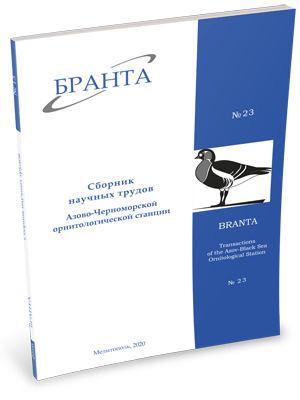
Transactions
of the Azov-Black Sea Ornithological Station



Nesting of the Eurasian spoonbill (Platalea leucorodia) on the Utlyukskiy Liman (Zaporozhye region)
V. M. Popenko
In the 70s of the XXth century, the nesting of the Eurasian spoonbill in Ukraine was known only in the lower reaches of the Danube and Dniester, and at the beginning of the XXIst century, it began to spread to the East and the Eurasian spoonbill began to nest on the Tiligulskiy Liman, Karkinit Bay, Western and Eastern Sivash. Since 2016, the Eurasian spoonbill has been observed during the breeding season in the upper reaches of the Utlyukskiy Liman and the estuarine areas of the Bolshoy and Maly Utlyuk Rivers. According to observations that were held in 2016-2020, first there were: a pair with unproven nesting (2016), then flocks of up to 17-26 individuals (2018-2019). In 2020, both individual pairs with nesting behavior and flocks were found near a mixed colony of the Gray heron and the Great egret. Finally, on 24.05.2020, the Eurasian spoonbill nests were found in this colony. Among the 8 nests, one contained 2 eggs and two chicks, four nests contained 4 eggs and the other three - 3 ones. Nests are located on the periphery of the heron colony on clump of reeds. The height of the nesting platforms is about 4-70 cm above the water level, the minimum distance between the nests is about 4 m. It is possible that the flock of 26 adult and young individuals, that was observed on 2.08.2018, consisted of local nesting birds.
Thus, another nesting location was found in the South of Ukraine.
References:
- Busel, V. A. (2015). Breeding birds of Husynyi Island (Kakhovske Reservoir). Branta: Transactions of the Azov–Black Sea Ornithological Station, 18, 64-74 [in Russian].
- Chernichko, I. I., Diadicheva, E. A., Popenko, V. M., & Chernichko, R. N. (2017). Birds of the wetland “Shallow part of the Utliukskyi Liman” (north-western part of the Azov Sea region). Branta: Transactions of the Azov–Black Sea Ornithological Station, 20, 39-68 [in Russian]. https://doi.org/10.15407/branta2017.20.039
- Chernichko, R. N., Diadicheva, E. A., & Popenko, V. M. (2018). The retrospective review of the results of the monitoring in wetlands: Shallow part of the Utlyukskyi Liman. ROM Bulletin: Results of the regional ornithological monitoring,12, 8-9 [in Russian].
- Kostin, S.Yu., & Tarina, N.A. (2002). Rare birds of the Swan Islands Nature Reserve and the adjacent territories. Branta: Transactions of the Azov–Black Sea Ornithological Station, 5, 113-128 [in Russian].
- Petrovich, Z.O. (2000). Spoon-bill in the Ukrainian part of the Danube Delta. Branta: Transactions of the Azov–Black Sea Ornithological Station, 3, 117-121 [in Ukrainian].
- Poluda, A. M. (Ed.). (2018). Encyclopedia of migratory species of wild animals of Ukraine. Kyiv [in Ukrainian].
- Siokhin, V. D., Garmash, B. A., Diadicheva, E. A., Chernichko, R. N., Matsyura, A. V., & Popenko V.M. (2000). The Eastern Sivash. In Numbers and distribution of breeding waterbirds in the wetlands of Azov-Black Sea Region of Ukraine (pp. 251-338). Melitopol – Kiev: Branta [in Russian]
- Smogorzhevsky, L. O. (1979). Fauna of Ukraine. Gaviae, Podicipedes, Procellariiformes, Pelecaniformes, Gressores, Phoenicopteri. (Vol. 5). Kyiv: Naukova Dumka [in Ukrainian].